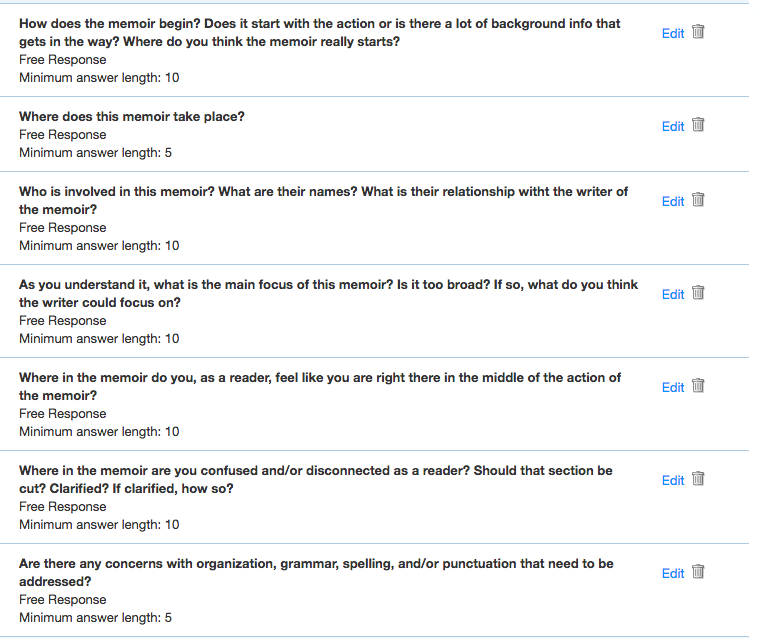Warnock really knows his audience and therefore starts the chapter off with the perfect guideline for someone like me who is often frustrated and overwhelmed by tech. “Don’t be any more complicated technologically than you have to be.” (19). Sometimes I place too high an expectation on tech tools and become frustrated when it cannot do what I expect it to do. As I read through this chapter I came up with this simple mantra, “use the tech, don’t let it use you.” Therefore as I work on adding more online features to my current f2f and plan my future online course I will focus on simplicity, functionality and purpose for the students while keeping this mantra in mind.
The LMS Battle – Blackboard, Moodle and Canvas
Blackboard
During my second year in college my chemistry professor introduced Blackboard as a component of the class. I found the platform difficult to navigate, not intuitive and terrible to look at. I think that experience left a bad taste in my mouth, coupled with the fact that chemistry was not one of my favorite subjects. Thankfully I never had to use Blackboard again…although I know it has evolved over the years.
Moodle
When I first started teaching at the college level I was introduced to Moodle. Since my classes were f2f I used Moodle only for attendance and the gradebook. I was forced to dive deeper into Moddle two semesters later when I was teaching a fully online American Lit class. I really loved Moodle. It was my favorite LMS because it was easily customizable, their turnitin feature was more seamless than Canvas and quiz building was easy. However navigating Moodle is difficult on mobile devices.
Canvas
I love Canvas support! And for this reason Canvas wins over all the other platforms in my book. Whenever I call the customer care line there is always a knowledgeable and patient service person on the other side to help me. Canvas is also more intuitive than Moodle and more customizable with graphics (although I still think it’s a bit static and can borrow some customization ideas from WordPress). Navigating Canvas is easy on mobile devices and you can almost do anything on your cellphone that you can do on a computer. I think this gives Canvas the biggest edge over the other platforms because mobile is the way of the future. I love Canvas’ mobile interface because I usually ask my students to use their smart phones to look things up or even to complete assignments.
Canvas is the LMS that most closely fits my teaching philosophy and framework because it most closely mimics the in person feel. Canvas’ intuitive tools and environment allows me to customize the experience for my students and myself.
My Comp. Tools:
Canva design tool
Canva (not the LMS) is a design tool that allows you to create beautiful and quick infographics and designs for free on a computer or mobile device.
I love this tool! I usually ask my students to create memes, quotations and graphics from their readings and work. This helps to put them in a creative space so that they can see the work outside the box. Some of the students end up posting their quote images etc. to social media….instagram, twitter, pinterest.
https://www.canva.com/
Creative Commons
This site offers music, art and photography in the public space that students can use to make their projects more interesting.
https://creativecommons.org/
Unsplash
I use this resource to get free images for my content pages for Canvas, my WordPress site and for guest blog posts. The images are amazing and you can find almost anything.
SWANK – Miracosta library
Sometimes we watch movies for class. I usually watch 30-40 minutes of the movie in class as a shared experience and then I share the Swank link so that they can finish watching at home.
Zoom
Since Zoom is free I was also thinking of incorporating it into group work activities. The groups will be required to meet online at a time convenient to them and record the meeting as evidence. I am also thinking of doing online Zoom meetings as extra credit for my in class group to test the effectiveness of this idea.
I want to offer a few live Zoom meetings in my online class because I believe that communicating in real time through media such as this enhances learning and creates social connection, which is a very important part of the college experience that gets lost in online education.
Others:
GoogleDocs, Youtube,
In Canvas Tools I Love
The Gradebook
Before I discovered the Gradebook I asked my husband to build complicated excel sheets to store my students’ grades and that was just a nightmare. I rely on the Gradebook to store and figure out my grades since it makes the transfer from points to percentage seamless.
Rubrics
This week I worked with a colleague to figure out how to add a rubric to my turnitin assignment…that was loads of fun. Having the rubric directly in Canvas will save me a lot of time and I am so happy that I finally transitioned to online grading rubric (although I haven’t officially used it yet… I will give you guys an update on my experience in the week ahead). I haven’t tried the Canvas rubric tool yet but I intend to try that out for my next assignment.
Group work and collaboration
Canvas group selection tool is more arbitrary and takes away the work of manually assigning groups. Each group gets their own homepage where they can chat, collaborate on documents and share ideas. This home page allows me to get access to each group’s project and creates a central place for them to share the project on the projector in an f2f class or on a discussion board in an online class.
Peer Reviews
I am thinking of incorporating online peer reviews in my f2f class as practice for my online class. I found tutorial videos on YouTube and I am fascinated by the versatility of online peer reviews. I used to think that I’d have to give this up for an online class but Canvas makes it just as effective and easy to do online as in class.
Here are some interesting tutorials
Assigning Peer Reviews
https://www.youtube.com/watch?v=dQ41vB-nQ50
Collaboration in class
https://www.youtube.com/watch?v=GzJ1nz5c65s
Setting up shared Google docs
https://www.youtube.com/watch?v=p2b00iPzxFI
Embed Google slides directly to canvas
https://www.youtube.com/watch?v=6GgGe0BWFB4
Grading discussions
https://www.youtube.com/watch?v=lo5E79ETGTc
How many new tools per unit?
I think more than three tools per unit is too many. Sometimes too many choices can lead to confusion especially in an online course where you and the students are only communicating on the page. A page that is overcrowded with tech diminishes its usability. As I plan my online course I will try to keep two to three tech options per unit. I will maintain a practice of testing options to see which ones are more favorable with the students. I am not sure if Canvas has any A/B testing features but that would be a great add on to see which resources are most valuable to students so that the course can evolve and reflect the best tools. I want to stay away from the assumption that since I like a tool, the students will also find it effective.
How do you measure if a tool is effective?
This is a great question and it leads me to ask whether or not Canvas has A/B testing capabilities. I think for now the best way to measure is by student feedback. I am using this semester’s f2f as a beta group to test certain tools and get the students’ feedback while we are in the f2f space so that there will be less problems in an online class.
New tools I learned in this unit:
Padlet:
OMG! Thank you Curry for introducing me to Padlet! Poster boarding is a huge part of my class and I was worried about loosing that in the online space
https://padlet.com/create
I signed up for Padlet and I’m going to experiment with it. My only issue is that it seems like I will have to ask each student to sign up and it doesn’t have a doc sharing option like GoogleDocs where more than one student can build a board together. I use poster boarding as a collaboration tool and without this ability it kind of diminishes my purpose.
Prezi
I love how prezi looks and I would like to experiment with it but I don’t think I want to pay $7/month for something I’m not going to use all the time. I could really see myself using this tool to increase engagement and learning.
https://prezi.com/pricing/
On page 26 Warnock suggests that publisher sites can be a great resources for tools through interactive texts and add ons. I haven’t found a text I love yet but as I look around I will bear this in mind. I think having an interactive text with frameworks already built by the publisher is a great added bonus.
P.S. Curry the last FERPA link on the unit page does not work
Also can we get access to a course shell where we can practice the techniques we are learning here in real time?


